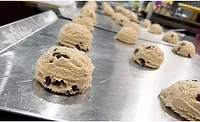Step Two: Color your world

The use of color in food plants is not new, yet in today's world of colored lighting, injection molded plastics and tinted cleaning supplies, a rainbow of color is at your fingertips. Color is a wonderful tool for enhancing food plant sanitation and can be used in many areas of the plant, including design, lighting, accessories and cleaning supplies.
In food plant design, more plants are now using white reinforced Plexiglas (RFP) for walls and ceilings. The first reason is obvious: ease of cleaning. White also reflects light and helps keep the work areas bright. Operators must be able to see what they are doing and complete their work in a comfortable environment. There are also studies that show that people associate white with cleanliness. In fact, the clean and white processing environment may subconsciously remind the workforce to keep the area clean.
Another application of color is lighting on processing equipment, especially those that have a role in assuring food safety like metal detectors, check weighers, can washers, dud detectors, and air cleaners. Sometimes half the battle to improve food safety is to remember to turn on these units. I have been in several plants where operators neglected to start these machines. These occurrences were more common with washers or blowers that are often located above or upstream of a filling machine. Nevertheless, one of the easiest means for management and staff to quickly determine whether the unit is running is to fit the unit with red and green lights. If it is off, the red light is on, which serves as a beacon to push the "on" button.
Color is also used in food processing plants to minimize the potential for contamination, dispose of waste and make cleaning more efficient and effective. Suppliers manufacture plastic totes, buckets, carts, bins, scoops and other containers and utensils in many different colors-and the food industry can use that to its advantage. Using color-coded containers and utensils for handling specific classes of foods and food waste is an easy way to help assure proper handling. Processors may designate that only white containers be used for ingredients, whereas all inedible waste products may be placed in black drums or bins. Operations handling potential allergens are taking this one step further. Many will designate that allergen materials only be handled using scoops, totes or buckets of certain colors. Green and yellow are the most popular colors for these applications.
Cleaning supplies can also be color-coded. Plant management may mandate that only black squeegees be used for cleaning floors, whereas white or yellow ones may be used on food contact surfaces. Consider the benefits of color at any level, even scrubbing pads. Many plants issue green scrubbing pads for cleaning equipment. These pads are abrasive and could damage equipment. Consider switching to a white pad or something that is less abrasive. Whatever color you choose be sure your cleaning program does not damage any equipment in the process.
The key to color is not only understanding how its inclusion in your plant simplifies sanitation but also communicating the importance of these colors to your staff. Make sure the staff understands both the system and why it has been put in place. To the average person, any container seems like a good vehicle for transporting waste. Conduct appropriate training programs and be sure to tell your staff the purpose of each colored container, utensil or squeegee. Post multilingual reminders around the plant. Your best intentions could become moot without proper training-and all the colors in the world wouldn't make a difference.
Looking for a reprint of this article?
From high-res PDFs to custom plaques, order your copy today!



